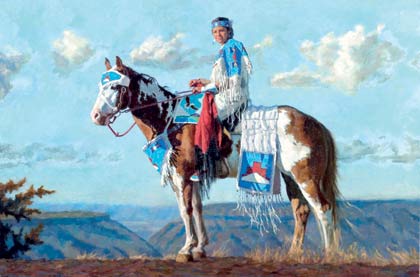“I try not to paint eyelashes, unless they are really important,” says artist Lynda Lanker, whose portraits of women of the West are as intimate and forthright as the flesh-and-blood women they depict. Though some of Lanker’s work is so detailed that for a moment the portraits appear to be photographs, even her more abstract pieces capture a sense, a feeling, of these generations of ranch women and cowgirls.
“Tough by Nature” represents almost 20 years’ worth of painting, sketching and interviewing 49 women in 13 western states. It captures not just a moment in time, but also a spirit. The exhibit, which is accompanied by a book featuring the portraits and interviews with the women, presents Lanker’s work in pencil and charcoal, oil pastel, egg tempera, plate and stone lithography, engraving and drypoint. “Tough by Nature” opens at the Jordan Schnitzer Museum of Art (JSMA) at the University of Oregon on July 1.
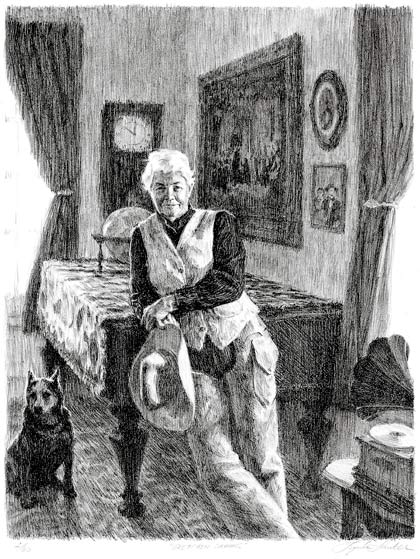 |
| Gretchen Sammis, 1997, Stone lithograph |
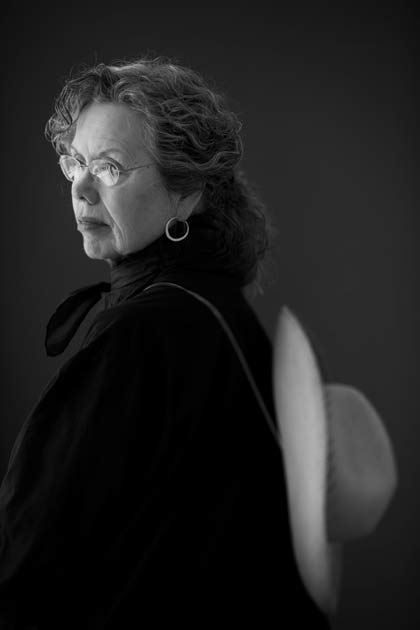 |
| Lynda Lanker, photo by Brian Lanker |
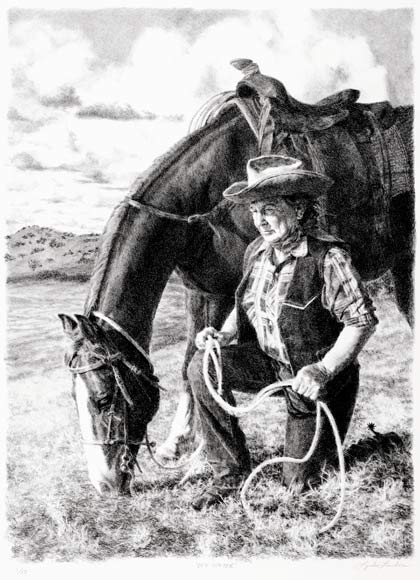 |
| Bev Walter, 2004, Stone Lithograph |
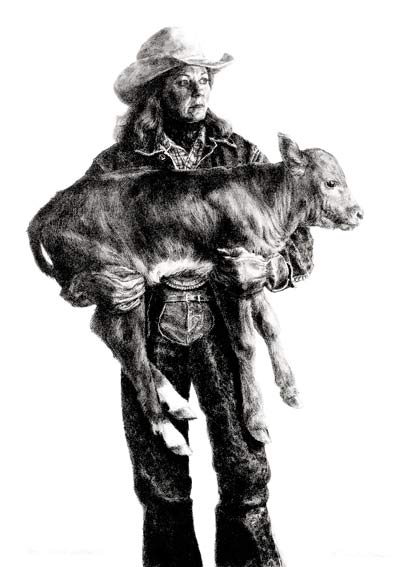 |
| Linda Jarrad, 1999, Stone lithograph |
Lanker explains what she means when she says her work seeks to evoke the feeling of these women and their lives: “They can have their head turned just so you can see the tip of their nose and the edge of their face, but you can evoke that person.”
She asks, “Have you ever had a dream where on the outside someone looks like your neighbor, but you think ‘Oh no, that’s my sister’?” You sense who that person is.
Lanker has a long history of creating portraits and evoking a sense of the people in them. In the course of her career she has painted five commissioned portraits of UO presidents — all male, all dressed formally.
In contrast, the women of “Tough by Nature” are for the most part in their everyday ranch wear. “Most of us aren’t at our most authentic, dressed up for the camera,” she says. “That’s a mask.” Though, Lanker muses, perhaps those UO presidents, who spent so much of their time in suit and tie, felt most themselves when dressed that way.
Unlike many of her portraits, the artwork of “Tough by Nature” wasn’t commissioned, which gave Lanker more freedom. And as for the women: “They didn’t have a façade, which made them so delightful to work with,” Lanker says. “They were just who they were, right from the beginning.”
In his introduction to the exhibit’s book, also titled Tough by Nature, Larry McMurtry, author of novels of the American West such as Lonesome Dove, writes: “… you can tell a ranch woman by the wrinkles — shallow at first but deepening into arroyos, gullies, little canyons as the wind and sun work on them. And it’s not just their cheeks that are tanned: the depths of the wrinkles are tanned too.”
Lanker uses the tiniest of paintbrushes, a 00000 (five aught), for her detailed, intimate egg tempera works such as the rug that hangs behind Elladean Hayes Bittner of the “Quien Sabe” Outfit ranch. And Bittner, who died in 2008 in her late 80s, bears those classic wrinkles proudly as she stands holding a lasso and wearing a belt buckle that reads “BOSS.”
That painting took Lanker two years to complete. “I’m kind of an obsessive painter, you might say,” she laughs.
The 1993 engraving of Lois Stevenson, with cattle from her Eugene-area Knee Deep Cattle Company in the background, goes another route in its depiction of a strong woman of the West. The drypoint engraving uses that medium’s characteristic blurred lines to create another, less detailed but equally personal image of a strong woman, looking directly into your eyes. More than half the portraits in “Tough by Nature,” like this engraving, are black and white.
“I love black and white,” Lanker says. “It has a certain level of abstraction. I think it shows character particularly well.” Color can be distracting, she says. “You have to have a reason to use color.”
Lanker admits that she didn’t realize at first how unusual it is for a portrait artist to work in such a diversity of media. “Part of it is keeping myself challenged,” she says.
Her portrait of cowboy poet Georgie Sicking is a 16-by 20-inch egg tempera, while some of her charcoals, including one of barrel racer Jenna Johnson of Oregon’s Warm Springs Indian Reservation, are 36 by 66 inches wide.
“It’s five-and-a-half feet wide.” Lanker says, gesturing to one of her broad charcoals. “You can immerse yourself in it. The size is kind of exhilarating.”
Stevenson, in an oral history interview that accompanies her portrait in the book, voices the concerns many of the women ranchers shared with Lanker, saying “I don’t agree with the problems environmentalists have with ranching because I think we are environmentalists as well as anybody. Most ranchers have to take care of the land. I mean it’s how they make their living.”
Lanker agrees. “All the people I dealt with are very careful about the land,” she says, adding that, that ranchers are “pretty much demonized” by some — not all — environmental groups. “It’s such a treasured way of life to them,” Lanker says. “They love being outside on a horse with the sky overhead.”
Stevenson’s Knee Deep Cattle Company is known these days for its certified humane, grass-fed, free-range cattle. The animals are herded on horseback, with the family’s border collies and on Honda four-wheelers. Stevenson will participate in August in a panel on land use and preservation as part of the JSMA exhibit.
It’s not hard to see how Lanker’s project became not just paintings but oral history. Petite, with graying hair and a charming smile, she doesn’t just answer questions about her art; she converses, asks questions herself. Lanker is interested in the women she depicts not simply as objects of art, but as people and as a culture. She says that the idea to start recording her conversations with the cowgirls and ranch women came from her husband, Brian Lanker, after she would come home from her trips around the West and tell him about the lives of the women she was working with.
Another theme that permeates through Lanker’s paintings and interviews is the mingled pleasure and pain of ranch and rodeo life. “I’ve walked out of the arena with broken legs before,” two-time women’s world champion bull rider Jonnie Jonckowski told Lanker, “because the crowd gets so flattened if a gal gets hurt.”
Still others tell of raising children and of warming frozen calves in the kitchen, and Lanker’s portraits show them with their working dogs, their horses, their trucks and their kids. Some of them look tired, others pensive and still others purely joyful.
And tied to the topic of what is the highest and best use of the last of America’s open spaces are the worries the women voice about losing their ranches to development or to large corporations that raise animals on feedlots instead of on the range.
“Ranching isn’t about to die, because of demand for the product,” Elizabeth “Bet” Kettle, who raises Hereford cattle in Colorado, told Lanker as she sat for her portrait in 2007. “But the future of ranching will be big ranches, agribusinesses.”
Lanker also knows about loss, if not the loss of the land. “I’m an urban person,” she says. “I’d never been on a ranch or a farm.” She’s survived the loss of a loved one. Her husband, Pulitzer Prize-winning photographer Brian Lanker died while work for the exhibit was still under way.
“He was so supportive,” Lynda Lanker says. “At the beginning of 2011 he said ‘This is my project for the year.’” But Brian Lanker died in March of that year, though not until after he had designed a mock-up of the book for the show, and asked McMurtry, Maya Angelou and retired Supreme Court Justice Sandra Day O’Connor to write pieces for it.
“He had the vision,” Lanker says of her husband. “He was definitely my biggest fan.”
Now that her nearly two-decade project has wrapped up, Lanker says her next work is a commissioned portrait — a lithograph of Betty Roberts, the first woman justice on the Oregon Supreme Court.
“Tough by Nature: Portraits of Cowgirls and Ranch Women” goes on display at the Jordan Schnitzer Museum of Art from July 1 to September 9, 2012. Free opening reception, 6 pm Saturday, June 30.
Panel: Ranch Women and Cowgirls Tell their Stories
2 pm Sunday, July 1
With bull rider Jonnie Jonckowski, Eugene-based Eastern Oregon ranch-owner Susie Papé, cowboy poet Georgia Sicking and local rancher Lois Stevenson
Artist Talk: Lynda Lanker
2 pm Saturday, July 7
Family Art Round-Up
1 pm Saturday, July 14
Explore the West in “Tough by Nature” and make “cowhide” paintings and wire sculpture horses.
Museum After Hours: Hoedown and Film
6 pm Wednesday, August 8, $5; free for members
Dancing, film and tours of the museum; free outdoor screening of Cat Ballou at 9:30 pm
Panel: Land Use and Preservation
5:30 pm Thursday, August 9
With Gerda Hyde, Billie Roney and Lois Stevenson
